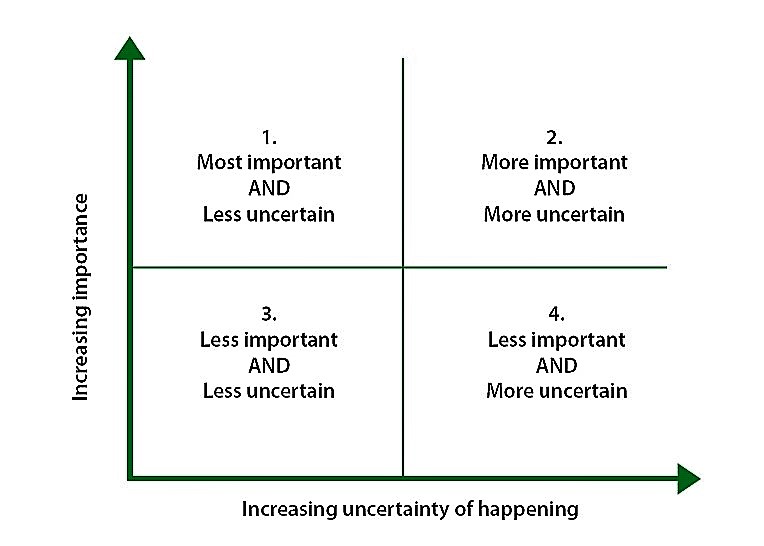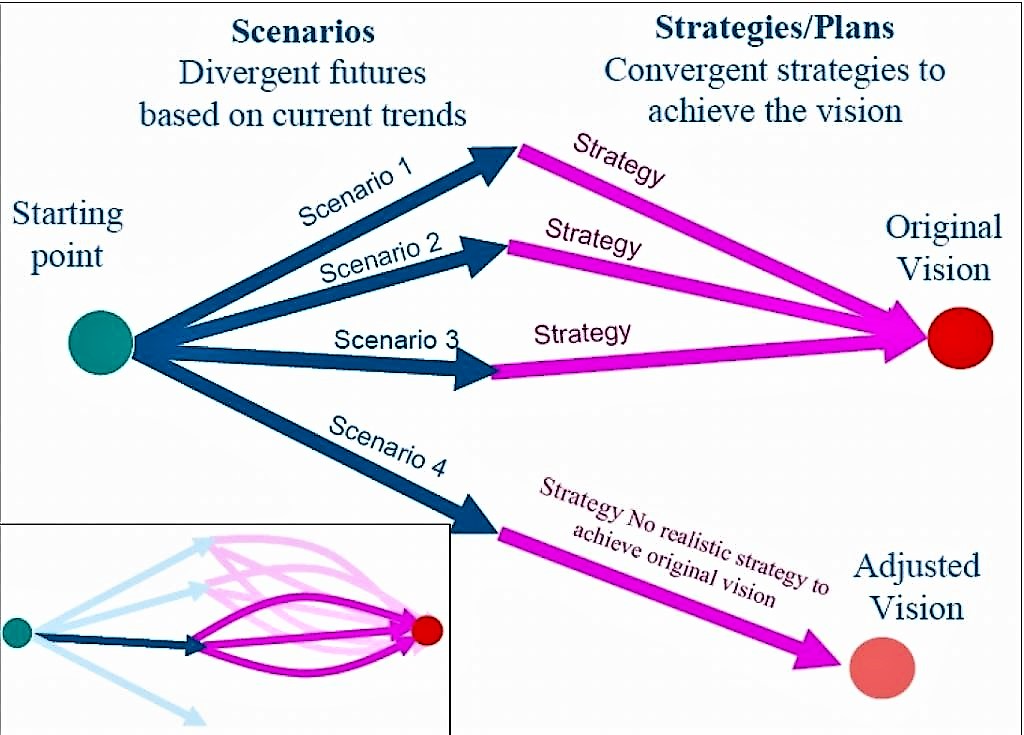Scenario building can be described as a story which is based on the analysis and understanding of current and historic trends and events. It includes a consistent description of possible future situations. The development of sets of narrative scenarios helps to identify possible pathways towards a vision of the future. Scenario building can be done by an individual or by a stakeholder group and should focus on the main issues covered by the vision.
(Adapted from MORIARITY et al. 2005)
A scenario can be regarded as a story about the way the world might turn out tomorrow. Because there are numerous possibilities how the situation can be in the future, a scenario cannot be considered as a specific forecast of the future, as this is often the case in terms of water management. It is more a plausible description of what might happen (a vision, in contrast, is a desired future state – see also visioning). Such a description needs an extended analysis of current and historic trends and events in order to develop a realistic prediction. Therefore, when scenario building is used as an aid to strategising, it should focus on the main issues covered by the vision. Such main issues could be resource availability, condition of infrastructure and social demand concerning water management.
The process of scenario building should raise awareness (see PPT) of uncertainties, risks and constraints which could be encountered in the future. Examples for such constraints and risks could be illegal water use, old water network, high costs and many more issues (MORIARTY et al. 2005). The awareness of such factors helps to improve strategy development because scenario building allows switching mindsets from only one possible future towards thinking about a number of possible alternatives. Scenario building can also be used to develop strategies which are based on scenarios to reach a vision (MORIARTY et al. 2005). The stakeholders who take part in scenario building should build up to four or five scenarios. Each of those scenarios should be plausible, internally consistent and based on good quality information.

Scenario building involves preparatory work including vision development, stakeholder workshops and post-workshop activities (see also stakeholder analysis starting by stakeholder identification factsheet). Scenarios are built up by using a matrix. This matrix contains factors which are beyond the control of planners (external factors). External factors are used to develop scenarios. Factors that are within the control of planners (internal factors) can be applied to develop strategies (MORIARTY et al. 2005). The relevant steps to perform a scenario building session are:
- Step 1: A brainstorming should be conducted to identify all internal and external factors that will affect achieving the vision. After the brainstorming, a discussion should be launched in order to separate internal factors from external factors. A thorough understanding of the status of water resources and water supply as well as an understanding of location and severity of local water problems is essential, since it simplifies the identification of such external and internal factors (MORIARTY et al. 2005).
- Step 2: The next step consists of classifying the factors as it is shown in the figure. The factors in the upper-right quadrant which are labelled as the most important and most uncertain factors are used to differentiate between possible futures described by the narrative scenario. A reduction of these key factors to two or three factors helps to keep the number of possible scenarios low.
- Step 3: The identification of different future states for each factor is the next stage. The results have to be combined in order to come with the main storylines of different scenarios. The less uncertain or less important factors in the other three quadrants can be used to develop a “background story” that is shared by all the scenarios. Another discussion should be started which includes the classification of the scenarios as high or low probability.
- Step 4: Write down a series of narrative scenarios in which the factors from quadrant one of the chart provide a common background story to a set of diverging possible futures described by those factors in quadrant two. Depending on the length and detail of the scenarios being developed, factors from quadrants three and four can be included or left out of the write-up.


After the different scenarios have been written down, strategies are developed to meet the vision. Sometimes it is necessary to refine the vision since visions, being desired states, tend to be unrealistic. There is often a broad nature of scenarios, so that multiple strategies can lead to the vision. Once the numerous lines of visions, scenarios and strategies have been developed, they are assessed by specialists using analytical or modelling techniques with the aim of assessing the internal logic of the strategy and likelihood of it achieving the vision. The outcomes of this analysis are reported back to stakeholders leading to subsequent iterations.
Scenarios (and visions) can be built at the beginning of any planning process. The scenarios developed are in turn used as a basis for identifying potential strategies and plans to achieve the vision that are feasible and desirable in terms of equity, economic efficiency and environmental sustainability. It is important that stakeholders from all levels are involved in this process. A good facilitator is of utmost importance in this process.
The EMPOWERS Approach to Water Governance: Guidelines, Methods and Tools
The guideline provides information necessary to understand the EMPOWERS approach of water governance and explains in details how to use the approach for planning and implementation of water management and related issues.
MORIARTY, P. BATCHELOR, C. ABD-ALHADI, F. LABAN, P. FAHMY, H. (2007a): INWRDAM The EMPOWERS Approach to Water Governance: Guidelines, Methods and Tools. pdf presentation. Amman, Jordan: Inter-Islamic Network on Water Resources Development and Management (INWRDAM) URL [Accessed: 18.03.2010]Scenario building in local-level water resource management – experience from the EMPOWERS project with reference to a case study in Jordan
This paper was produced during an EMPOWERS symposium. The first part of the paper contains a description about how to best conduct scenario building workshop. The second part deals with a case study in Jordan where scenario building was applied. The steps and scenarios for this example of scenario building are well elaborated and give a good impression how scenario building can be used.
MORIARTY, P. SHRAIDEH, F. HADDAD, F. ALZOUBI, R. ABBADI, M. BATCHELOR, C.H. DE GROOIJER, G. (2005): Scenario building in local-level water resource management – experience from the EMPOWERS project with reference to a case study in Jordan. Proceedings of the EMPOWERS Regional Symposium: End-Users Ownership and Involvement in IWRM, 13-17. November 2005. Cairo: [Accessed: 14.12.2010] PDFBuilding a 2nd Generation of World Water Scenarios
This document briefly discusses the uses of qualitative and quantitative scenarios, and then reviews the status of global water scenarios and points out some of their major shortcomings.
ALCAMO, J. GALLOPIN, G. (2009): Building a 2nd Generation of World Water Scenarios. (= World Water Assessment Programme side publications series: insights ). Paris: UNESCO URL [Accessed: 14.12.2010]Comprehensive water management scenarios for strategic planning
This article focuses on strategic planning of water resources management. Scenario building can improve the process of planning as well as the efficiency, cost and environmental impact.
MANOLI, E. ; KATSIARDI, P. ; ARAMPATZIS, G. ; ASSIMACOPOULOS, D. (2005): Comprehensive water management scenarios for strategic planning. In: Global NEST Journal: Volume 7 , 369-378. URL [Accessed: 07.07.2019]Making inroads towards adaptive water management through stakeholder involvement, the NeWater experience in the Upper Guadiana basin, Spain
Spain is a country where water can be scarce and as result of this water scarcity, conflicts between different stakeholders can arise. Information and participation is essential to solve conflicts and scenario building helps to understand problems and main issues which could strengthen further in future.
MARTINEZ-SANTOS, P. VARELA-ORTEGA, C. HERNANDED-MORA, N. (2007): Making inroads towards adaptive water management through stakeholder involvement, the NeWater experience in the Upper Guadiana basin, Spain. (= =Proceeding of the CAIWA International Conference on Adaptive & integrated Water Management, 12th to 15th November 2007; Session E4 ). URL [Accessed: 07.07.2019]The EMPOWERS Approach to Water Governance: Guidelines, Methods and Tools
The guideline provides information necessary to understand the EMPOWERS approach of water governance and explains in details how to use the approach for planning and implementation of water management and related issues.
MORIARTY, P. BATCHELOR, C. ABD-ALHADI, F. LABAN, P. FAHMY, H. (2007a): INWRDAM The EMPOWERS Approach to Water Governance: Guidelines, Methods and Tools. pdf presentation. Amman, Jordan: Inter-Islamic Network on Water Resources Development and Management (INWRDAM) URL [Accessed: 18.03.2010]Using Visions, Scenarios and Strategies within the EMPOWERS Planning Cycle for IWRM
This working paper describes the approach which used by EMPOWERS to develop future visions of water resource management and of using scenarios as a tool to analyse key factors affecting the vision. Based on these scenarios potential strategies and plans are developed which could help to match the vision.
MORIARITY, P. BATCHELOR, C. LABAN, P. (2005): Using Visions, Scenarios and Strategies within the EMPOWERS Planning Cycle for IWRM. (= =EMPOWERS Working Paper No. 4 ). URL [Accessed: 07.07.2019]Scenario building for future water management in the Chakir Basin
This presentation includes a detailed examination of the current water management situation in the Chakir Basin. Following this examination the main issues are used to develop possible scenarios.
DUKHOVNY, V.A. (2006): Scenario building for future water management in the Chakir Basin. (= Proceedings of Integrated River Basin Management in Contrasting Climate Zones, 14th to 15th December 2006 ). Hohenheim: Rivertwin. [Accessed: 14.12.2010] PDFScenario building in local-level water resource management – experience from the EMPOWERS project with reference to a case study in Jordan
This paper was produced during an EMPOWERS symposium. The first part of the paper contains a description about how to best conduct scenario building workshop. The second part deals with a case study in Jordan where scenario building was applied. The steps and scenarios for this example of scenario building are well elaborated and give a good impression how scenario building can be used.
MORIARTY, P. SHRAIDEH, F. HADDAD, F. ALZOUBI, R. ABBADI, M. BATCHELOR, C.H. DE GROOIJER, G. (2005): Scenario building in local-level water resource management – experience from the EMPOWERS project with reference to a case study in Jordan. Proceedings of the EMPOWERS Regional Symposium: End-Users Ownership and Involvement in IWRM, 13-17. November 2005. Cairo: [Accessed: 14.12.2010] PDFWater and wastewater management in megacities – the Lima example
Scenario building was used for identifying the main issues for water management in Lima. It includes a comparison how the future could be with a vision, e.g. with goals to achieve and without any vision. It gives an outlook of scenarios how the future of Lima in terms of water management might be in 2040.
SCHUETZE, M. (2010): Water and wastewater management in megacities – the Lima example. (= =Proceedings of Future Megacities in Balance, 11th to 13th October 2010; Session B2 ). Essen: [Accessed: 16.12.2010] PDF

